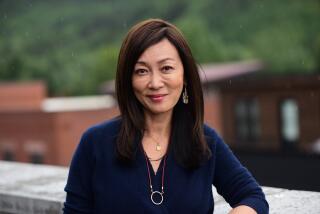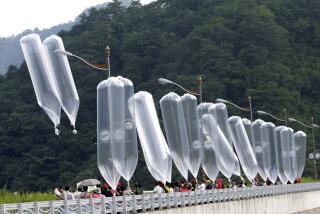Cold War-Era Files Reveal U.S. Fears of S. Korean Attack on North
- Share via
WASHINGTON — At the peak of the Cold War, American leaders were terrified that South Korean President Park Chung Hee’s heavy drinking and erratic behavior might lead him to attack North Korea, recently released U.S. government files show.
The South Korean leader, who ruled throughout the 1960s and ‘70s and was the architect of that country’s “economic miracle,” has been depicted over the years as a stern disciplinarian.
But long-secret files show that, as tensions mounted in 1968 after North Korea’s attempt to assassinate Park and its seizure of the American spy ship Pueblo, the Johnson administration feared that the South Korean president was unstable.
“He is moody, volatile and has been drinking heavily,” Cyrus R. Vance, who visited the South Korean leader as a special envoy, reported to President Lyndon B. Johnson and Cabinet officials, according to a transcript in the files.
“Is Park’s drinking irrationally something new?” Johnson asked.
“No, this has been going on for some time,” Vance replied. “He hit his wife with an ashtray. He has thrown ashtrays at several of his assistants.”
The files were released as part of the State Department’s periodic declassification of information for historians.
They show just how intensely the Johnson administration feared getting drawn into a new war on the Korean peninsula while the U.S. was fighting in Vietnam. At the time, Defense Secretary Robert S. McNamara equated the feverish White House deliberations over the spy ship Pueblo with those of the Cuban missile crisis in 1962.
“What’s wrong in telling the North Koreans they must get the ship to us by a certain date or face the consequences?” CIA Director Richard Helms asked at a meeting.
“The simple answer to that is that we do not want a war with the Chinese and the Soviets,” Johnson shot back.
The documents also serve as a reminder that Cold War dynamics were far different from the situation on the peninsula today.
As current South Korean President Kim Dae Jung has sought to forge a more peaceful relationship with the North, his supporters have worried that the United States is taking a more confrontational line. In 1968 it was the reverse: The Americans were in favor of negotiating and feared that Park’s government was too belligerent.
When South Korea set up a Ministry of Unification in 1968 to plan for reuniting the peninsula, which was divided into two nations after World War II, U.S. officials quietly tried to get explicit promises that Seoul’s intent was “peaceful” reunification. The South Koreans refused to make that commitment.
Park, who came to power after a 1961 coup and ruled for 18 years, has long been viewed as a deeply controlled man.
But Donald P. Gregg, who served as CIA station chief and U.S. ambassador in Seoul, confirmed recently that, to insiders, Park “was known as a drinker.” Another U.S. official who served in Seoul in 1968 said that after the Pueblo seizure, with Park drinking heavily and angry at the Americans, “we were very much afraid there was going to be a war.”
In an interview this month in Seoul, Kim Doo Young, who served as personal secretary to Park from 1968 to 1978, said the South Korean leader had been increasingly afraid of an attack by the North. But, he added, “I don’t believe, and wouldn’t think for a second, that he was thinking of invading North Korea. That’s absurd. Everyone knew that such a step would end up destroying both sides.”
“As for drinking,” Kim said, “he always liked to drink. And he used to drink a lot.”
Park was assassinated in 1979. His daughter, Park Geun Hye, who is vice president of South Korea’s opposition Grand National Party, declined to comment.
The newly released files also show that in the 1960s, although the U.S. government publicly and privately urged Park to open the way for greater democracy in South Korea, some officials in Washington sympathized with his authoritarian regime.
“All in all, instead of urging Park . . . to be more democratic, maybe we ought to tolerate a little more dictatorship in this messy fief,” Robert Komer, then a National Security Council official, wrote in a 1964 memo.
The tense crisis between the Johnson administration and Park erupted in January 1968 after about 30 armed North Korean infiltrators attacked the Blue House, South Korea’s presidential residence. A captured North Korean later said the mission was “to chop off President Park Chung Hee’s head.”
The attempt failed, but not before the North Koreans gained entry to the complex and forced a shootout that left several South Koreans dead. Five North Koreans died and two were captured.
On Jan. 23, less than two days later, North Korea seized the Pueblo and its 83 crew members as they were gathering intelligence off the Communist regime’s coast.
At first, Johnson and his top aides thought seriously about military action against North Korea to recover the Pueblo and its intelligence equipment, the files indicate.
They studied the possibility of seizing or sinking North Korean ships, mining the regime’s harbors, mounting a naval blockade, carrying out airstrikes or conducting raids across the demilitarized zone between North and South Korea.
Within short order, Johnson and his aides decided to negotiate with North Korea for the return of the Pueblo crew.
Over lunch on Jan. 29, Johnson and top aides decided their objectives were to get back the crew, to make sure that South Korean troops would continue to fight alongside U.S. forces in Vietnam and, most important, to “avoid a second front [war] in Asia.”
But one big obstacle stood in the way: Park.
The South Korean president was infuriated by the Blue House raid, American officials reported. He thought that the North Koreans should be punished with military action, both for that raid and for the seizure of the Pueblo.
U.S. Ambassador William J. Porter cabled Washington that “Park is almost irrationally obsessed with need to strike now at North Koreans.”
Park wanted to attack and eliminate the North Korean training centers and was incensed because the Americans were giving far greater priority to the Pueblo incident than to the raid.
Johnson sent Vance to Seoul with instructions to tell the South Korean leader that U.S. domestic politics were a factor behind the White House decision to negotiate with the North, the files indicate. “This is an election year in the U.S., and the [Pueblo] issue could become a major one in the campaign in such a way as to affect U.S.-ROK [South Korean] relations and our position in Southeast Asia,” Vance’s written instructions said.
The Johnson administration coupled its soothing messages with a warning: If Park threatened to pull South Korean troops out of Vietnam, the United States would respond by withdrawing American troops from South Korea.
After the mission, Vance told Johnson that Park was “a danger and rather unsafe.”
“President Park will issue all sorts of orders when he begins drinking,” Vance said. “His generals will delay any action on them until the next morning. If he says nothing about those orders the following morning, then they just forget what he told them the night before.”
In the end, Park went along with the U.S. efforts to negotiate with North Korea for the crew of the Pueblo.
But the American anxieties did not subside. Within two months, the U.S. Embassy warned Washington once again that South Korea was considering “military moves” or even “a preemptive strike against the North to effect reunification,” according to the internal documents.
The Pueblo’s crew was released in December 1968, after American negotiators gave North Korea an apology, which the United States immediately repudiated once the men were set free.
Park remained in power for another decade, surviving another North Korean assassination attempt in 1974 that killed his wife. He was shot and killed in 1979--not by the North Koreans, but by his own chief of intelligence.
*
Times staff writer Mark Magnier in Seoul contributed to this report.
More to Read
Sign up for Essential California
The most important California stories and recommendations in your inbox every morning.
You may occasionally receive promotional content from the Los Angeles Times.









